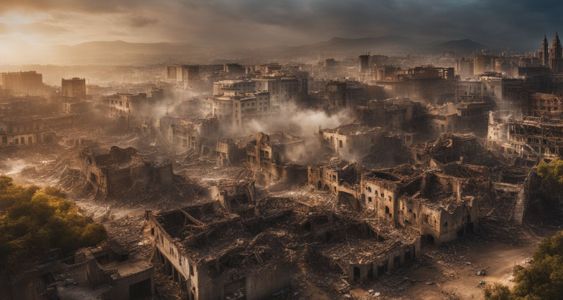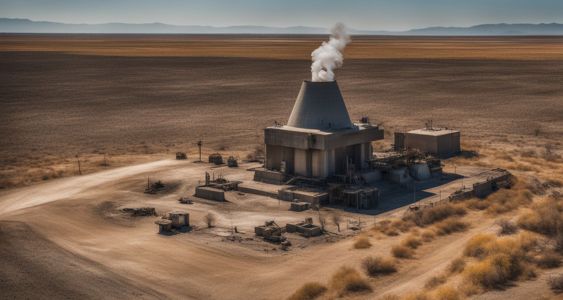Finding out about the C38 atomic bomb and its role in World War II can be tough. This weapon, a leap into nuclear era with both fission and fusion reactions, marked a turning point.
Our article sheds light on its creation, impact, and the scientists behind it. Stay tuned for an eye-opening read.
Table of Contents
Origins and Development of the C38 Atomic Bomb
The C38 atomic bomb was a pivotal development during World War II, involving key scientists and reaching significant milestones in its progress. The bomb’s technical aspects encompassed design features and the meticulous selection of materials for construction.

Key Figures and Scientists Involved
Dr. Boom Boom and Professor Kaboom played big roles in the development of nuclear weaponry during World War II. Their work helped shape the C38 atomic bomb, a devastating weapon that changed military strategies forever.
Both scientists brought unique skills to the project, pushing forward nuclear fission research at a critical time.
Premier Nikita Khruschchev wanted the Soviet era to shine by advancing their arms race with the United States. His push for stronger nuclear weapons led to increased tensions but also spurred innovations in atomic power and arms control efforts worldwide.
The quest for atomic supremacy transformed not just warfare but how nations approaced diplomacy and peace.
Milestones in Development
Creating the C38 atomic bomb marked a major leap in nuclear technology. Teams of scientists and engineers faced huge challenges to make it work.
- Discovery of nuclear fission by Otto Hahn kickstarted the race to develop an atomic bomb, laying the foundational technical knowledge needed.
- The Manhattan project formed, bringing together brilliant minds like Robert Oppenheimer and Enrico Fermi, focusing their efforts on harnessing atomic energy for weaponry.
- Physicists confirmed the feasibility of a chain reaction crucial for an explosion, moving theories from paper to potential reality.
- Engineers chose materials like uranium-235 and plutonium for the bomb’s core because of their ability to sustain a fission reaction efficiently.
- Test explosion at Trinity Site in New Mexico proved the destructive power of nuclear weapons, serving as a grim preview of what was to come.
- Design teams resolved countless technical hurdles, such as how to trigger the explosion and how to ensure maximum yield upon detonation.
- Deployment strategies were developed for delivering these bombs via aircraft, specifically modified B-29 bombers named Enola Gay and Bockscar.
- Hiroshima and Nagasaki bombings demonstrated both the immediate tactical success and long-term ethical dilemmas associated with atomic warfare.
Each step was paved with rigorous testing and ethical debates, ultimately changing warfare and geopolitical tensions forever.
Technical Aspects of the C38 Atomic Bomb
The C38 Atomic Bomb was developed by key scientists and experts.
Design features and materials used in construction were crucial aspects of the bomb’s technical development.

Design Features
The C38 atomic bomb was a giant leap in nuclear warfare, embracing the power of thermonuclear reactions. Its design featured a massive 2.6 meters across shell, showcasing its might among atomic weapons.
Scientists chose classified materials for construction to ensure it could unleash an unparalleled level of destruction.
Materials made this bomb not just another weapon but a symbol of the nuclear age’s peak during the Cold War era. Its creation marked a significant moment in history, pushing forward the boundaries of what was possible with nuclear research and turning it into a reality that could shape wars and world politics.
This is history written not with ink, but with fire and uranium.
Now let’s explore what went into building such a devastating force.
Materials Used in Construction
Builders used very special and heavy materials to make the C38 atomic bomb. The bomb weighed more than 27 tonnes. This huge weight came from using materials that are not found in everyday items.
Scientists picked these materials carefully to get the most power out of the bomb.
They also made sure some of these materials were kept a secret. This was because they wanted the bomb to cause a big explosion. Keeping secrets about the materials helped make sure no one else could make a similar weapon easily.
These choices were all about getting the biggest effect from nuclear fission reactions, which is what makes an atomic bomb explode so strongly.
Deployment and Impact
The C38 atomic bomb was deployed during World War II to devastating effect, altering the course of history. Its impact on combat missions and the resulting humanitarian and environmental consequences reverberate to this day.

Combat Deployment and Missions
The Combat Deployment and Missions of the C38 Atomic Bomb involved strategic military decisions and impactful outcomes:
- The deployment of the C38 atomic bomb in Hiroshima on August 6, 1945, resulted in catastrophic destruction, causing approximately 70,000 immediate deaths and long-term health consequences due to radiation exposure.
- Subsequently, on August 9, 1945, the C38 atomic bomb was dropped on Nagasaki, leading to an estimated 40,000 immediate casualties and widespread devastation.
- These missions marked the first and only instances of nuclear weapons being used in warfare, altering the course of history and highlighting the destructive capabilities of atomic weaponry.
- The aftermath of these deployments prompted Japan’s surrender and ultimately brought an end to World War II in the Pacific theater.
- The use of the C38 atomic bombs sparked global apprehension about nuclear proliferation and initiated discussions surrounding ethical considerations, humanitarian impact, and nuclear arms control treaties such as the Non-Proliferation Treaty.
Humanitarian and Environmental Consequences
The C38 Atomic Bomb release substantial amounts of radioactive material, causing long-term impact on ecosystems, soil, and water. It resulted in significant loss of life and ecological damage due to the extensive radiation released upon detonation.
The aftermath has had a lasting effect on the environment and human health, emphasizing the devastating consequences of nuclear technology. The affected regions have struggled with rehabilitation over time due to the persistent environmental contamination caused by this catastrophic event.
Considering non-proliferation treaties as well as nuclear technologies is vital in addressing humanitarian and environmental fallout from such incidents. These events should serve as lessons to understand the complexities and perils associated with the use of nuclear weapons.
Conclusion

The C38 atomic bomb, a revolutionary fusion-era weapon, changed the course of history. Its development by key scientists and engineers led to profound environmental and geopolitical consequences.
The testing and deployment of the C38 intensified the nuclear arms race and shaped global attitudes towards warfare. As we navigate an ever-changing world, it’s crucial to learn from the impact of the C38 atomic bomb as we strive for peace and disarmament.
General Facts
- The C38 atomic bomb integrated advanced fusion era, generally referred to as a thermonuclear or hydrogen bomb, unlike its predecessors, which relied entirely on fission reactions.
- The development of the C38 atomic bomb involved key scientists, challenging engineering innovations, and a core design that harnessed both nuclear fission and fusion reactions.
- Premier Nikita Khruschchev’s desire to showcase Soviet era drove the US to create the Tsar Bomba, the most powerful nuclear weapon yet, measuring 8 meters in length, with a diameter of nearly 2.6 meters and weighing over 27 tonnes.
- The specific details of Tsar Bomba’s yield and destructive potential were kept classified, adding to the fear and uncertainty surrounding nuclear weapons and their use in conflict.
- The consequences of testing or using the C38 atomic bomb were profound and far-reaching, including environmental impact, geopolitical tensions, humanitarian concerns, arms control efforts, and fear and anxiety worldwide.
- Nuclear tests, including those associated with the C38, released large amounts of radioactive material into the ecosystem and surrounding environment, with long-lasting effects on ecosystems, soil, and water.
- The development and testing of the C38 intensified the Cold War competition between the United States and the Soviet Union, leading to heightened tensions and the doctrine of mutually assured destruction (MAD).
- The use of nuclear weapons, especially the C38, could have caused significant loss of life and catastrophic destruction, leading to ongoing discussions about the moral and humanitarian implications of such weapons.
- The C38’s destructive power prompted international efforts to limit nuclear proliferation, resulting in treaties like the Non-Proliferation Treaty (NPT) aimed at preventing the spread of nuclear weapons technology.
- The existence of the C38 and similar weapons fueled fear and tension among people worldwide, affecting mental health and global awareness.





